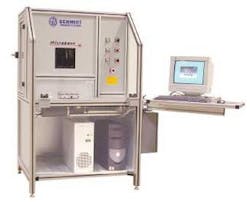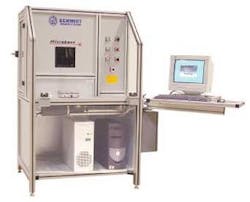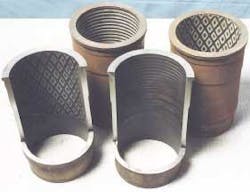Laser activity heats up in China
Systems suppliers are working overtime to meet the growing demands of Chinese industry for industrial laser processing products
Recent visits made to process developers and industrial laser product suppliers in Wuhan and Beijing, China, confirmed earlier reports of heated activity in the industrial laser market by Contributing Editor Keng Leong, (ILS April 2004 and September 2003) and Professor Xianoyan Zeng (ILS January 2003). Before ILS is accused of hyping the China market, consider this: by most accounts, which I confirmed in a meeting with the Laser Material Processing Commission of the Chinese Optical Society—the group responsible for generating annual product numbers for industrial laser production—Chinese companies ship about 2000 lasers per year.
According to ILS records there are 40 companies actively selling industrial laser products in China. And there could well be more. Those ILS has listed are mainly clustered in three cities, Wuhan, Beijing and Shenzhen. Smaller numbers are located in Shanghai, Guangshou, Xi'ian, Dong Guan, Wenzhou, Ri An, Ji'Nan and NanJing.
Although it would be beneficial to visit all the suppliers, it is physically impossible to do so in a two-week period. So what you do is to try and cover the largest number in a doable time period. Besides, the others can be visited on subsequent visits.
Many of these companies (33%) either manufacture their own lasers for sale to others or integrate them into their own processing systems. The remainder (66%) purchase lasers from domestic or international laser suppliers. Of these, several have made agreements with suppliers seeking to market their lasers in China.
Laser systems produced are predominantly used in marking applications (~60%) and engraving (~40%). Cutting (40%) is the third largest application served by the products of these companies. (Note: percentages do not add up because companies produce more than one type of system.) Laser power tends to be on the low (<150W) side in general as only a few Chinese companies have developed high-power laser capability. Several companies do have arrangements with international suppliers of high-power lasers to fill application needs.
As stated, marking and engraving are currently the largest applications driven by a variety of domestic markets. Chief among the other major applications are the following: button marking (China must be the leading supplier of laser marked garment buttons in the world), cloth marking (your daughter's favorite jeans bear pseudo wear marks produced in China), cigarette perforating (expected to remain a growth market in under-developed countries for several years to come), wheel rim marking, welding carbide tips on saw blades (one company has installed ten production lines with diode lasers for this application), cylinder liner heat treating, laser texturizing of steel rolls, welding of steel strip, metal cutting (estimates range to 100 user companies), ceramic scribing and battery welding (a market driven by the handheld communications industry). One company visited, Chutian Laser (Wuhan; www.chutianlaser.com) is shipping 100 pulsed, solid-state lasers for battery welding every month, and it cannot meet order demands, which now call for 140 units per month. This company's annual turnover is in excess $15 million USD.
The majority of the industrial laser suppliers in China are busy meeting domestic demands, so few have begun to explore the export market. Those who do are shipping to other countries in Southeast Asia, and the most popular export product is marking systems. This happens because competitive Chinese laser markers are priced well below those of international suppliers. And these systems provide equal capability in terms of marking speeds and throughput. One supplier, Beijing ZHD (www.zhdlaser.com), who, at $4.2 million USD, does not export at this time, prides itself on providing on-the-fly marking in competition with industry giants Domino and Videojet at a greatly reduced selling price. And it is already developing its own sealed-off CO2 laser source to further reduce the selling price.
On the high-power end of the market, only a few Chinese suppliers have products to offer. Those that do are either selling products of international suppliers, such as Rofin Sinar or Prima Industries, or are companies that are selling self-developed cross flow CO2 lasers for heat treating, cladding or saw blade welding applications (this latter a market expected to grow 40% per year). Among these are HG Laser (Wuhan;. www.hglaser.com), which is a public company doing about $15 million USD, Wuhan Unity Laser (www.unitylaser.com) with an annual turnover of about $30 million USD and Goldensky Laser (Wuhan;. www.goldensky.com), which does about $10 million USD annually. The latter claims that it can sell a 3kW output cross flow CO2 laser for 1/4 the price of an equivalent fast axial flow unit.
China Daheng (Beijing;. www.dahenglaser.com) does approximately $10 million annually selling low-power RF-excited CO2 lasers (purchased) for cutting and diode-pumped solid-state lasers for marking. The latter, selling for about $20,000 USD, totals about 150 units per year. The company also has supplied about 200 units for truck cylinder liner refurbishing, a market it claims will continue until every town in China has a unit to repair cylinder liners.
Jewelry welding and silicon scribing are other strong markets for Chinese lamp-pumped solid-state lasers. And we saw imported fiber lasers from IPG (Oxford, MA) being tested for both of these applications at HG Laser. Other applications about to develop for solid-state lasers are micromachining at companies clustered in the Pearl River and Yangtze River Deltas and lasers to process flat panel displays, a growth industry in Taiwan.
What are the prospects for China's industrial laser suppliers to turn their attention to exporting? Outside of the fact that exporting is an onerous prospect for many of these companies because of the need to improve laser packaging, compliance with standards and documentation as well as the usual exporting concerns with spare parts, service and qualified selling teams, Chinese manufacturers have a growing domestic market that they will be hard pressed to serve now.
At a series of seminars I conducted at three universities on this trip I showed a slide outlining why the future for industrial lasers looked bright globally. Each of the points I made applies in spades to China. First, consider that China's economy is booming, some say it is overheated. In 2002 there were more than 2 million private enterprises, twice the number of State owned, producing products for the Chinese and export markets. This has led to a consuming middle class of about 100 million people who are ready to spend to buy domestic and imported goods.
My list of industries offering growth opportunities for industrial lasers (parenthesis) focused on China looks like this:
- Automotive (welding, cutting and marking applications)—According to the South China Morning Post (1/6/2004), China will surpass Japan as the second largest car market in 2007. Already the majority of cars sold are built in China.
- Consumer buying (nonmetal cutting and marking)—Sales of cosmetics exceeded $6 billion in 2003 (South China Morning Post, 1/28/04); in 2004 China will have 26% of the world market for DVD players (South China Morning Post 2/9/04); and the country's retail spending is expected to exceed $700 billion in 2010.
- Semiconductor (drilling, trimming, marking)—.The Semiconductor Equipment and Material Institute forecast in March that China will account for 24% of the world's sales of chips.
- Medical devices (welding, marking)—China is poised for strong growth in foreign investment in hospitals, according to the South China Morning Post (2/6/04).
- Fabricated metal products (cutting)—The China Machine Tool News (3/5/03) projected that machine tool consumption would increase to $6 billion USD in 2003. According to Business Week (1/26/04), producers of flat rolled steel doubled to 25 in four years. The Laser Materials Processing Committee of the China Optical Society estimates that there are 200 laser cutters installed in China, half of which were of domestic manufacture.
So there appears to be bountiful opportunities for Chinese laser suppliers to focus on domestic markets, before they undertake the travails of international marketing. The one exception is in the marking/engraving field where I saw products that can successfully compete in the international marketplace if some attention is paid to standards compliance and documentation.
The obvious question is what opportunities exist for international suppliers to enter the Chinese market? Many already have, through joint ventures, marketing agreements and, in some cases, outright local organizations. The issue is selling price of course, based on the low labor rates in China and the fact that many of the larger applications are being served by less sophisticated lasers, such as the market for cylinder liner heat treating systems.
China is a big and important market. At some point in time industries in the country may become the supplier of choice of industrial lasers to all of Southeast Asia, as economies in that region swing to rapid growth. All in all China is where the action is at this time and although it resembles the Wild West occasionally, most of the domestic suppliers are well managed and staffed. It's a revelation to see how rapidly these companies have grown and more revealing to see how a country has seized on laser technology as a solution to business needs. Much of this results from strong university/industry relationships and interactions. Proof of this is seen in the many companies now run by former graduate students from the country's leading technical universities.
As an example, lecturing at Tsinghua University in Beijing, I was asked a series of questions regarding laser tailored blank welding by a graduate student. It turns out this young lady was about to start work at a system supplier developing a laser blank welder for the auto industry.
Flying home, reviewing my trip notes, it occurred to me that the industrial laser scene in China today resembles the situation in Germany several years ago when the advance of laser processing was predictable by the laser knowledge shown by potential users. In Germany, university graduates trained in laser applications prompted industry to accept this technology. In China, cadres of graduates, trained in laser technology, are being placed in key industrial situations where they will rapidly affect the growth of laser processing. Their impact is already being felt as evidenced by the applications cited above.
They have got a ways to go in China because it's a nation of contrasts. This was brought home to me as I was being driven from Wuhan 275 kilometers across central China to visit the Three Gorges Dam project. For about 125 kilometers along the straight four-lane highway both sides were lined by rice paddies, being tended by farmers using water buffalo to turn the earth. Every once in a while I saw a farmer using a two-wheeled tractor in a paddy right next to one being cultivated by an animal-powered plow. I couldn't help thinking that this situation points up the dichotomy in China today, a John Deere in one paddy and buffalo in the next.


